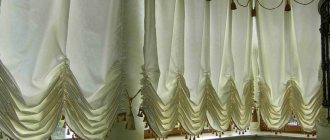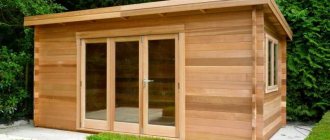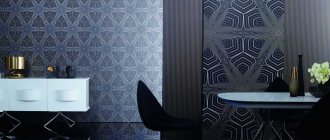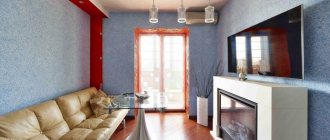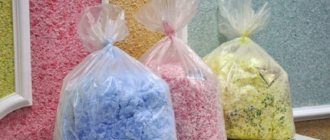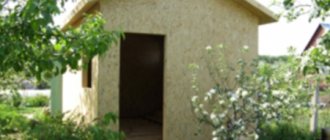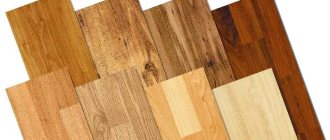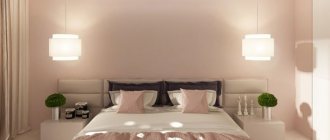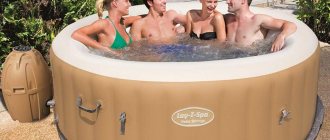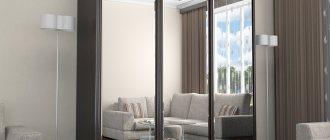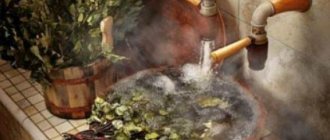When choosing flooring, everyone is guided by their own considerations. However, everyone agrees on one thing: the aesthetic appearance and durability of the new floor. In the huge assortment of these materials, one stands out - laminate, which, according to its characteristics, is perfect for finishing residential premises. Manufacturers are constantly improving their products - this is how expressions such as chamfer, lock and click locks and more have come into use.
Today you can easily buy laminate with or without chamfer. Which is better? The question is by no means rhetorical - the answer must be sought in the advantages and disadvantages of each of them, reviews and opinions about them.
Laminate with and without chamfer: what's the difference?
Beveled laminate is laminated parquet with a beveled edge. Beveled recesses, called chamfers, give the boards a visual resemblance to full-fledged expensive parquet. If there are no gaps, you can immediately notice the artificial nature of the coating.
Recesses on the edges are applied either on two sides along the length of the board, or on four sides along the perimeter. Accordingly, a distinction is made between laminate with a chamfer - two - and four-sided. The technology of applying recesses to the board involves indentation and special pressing, which uses special rollers, so its width and hardness are not reduced, and the protective layer on the edges is also preserved.
The shaped recess is obtained by trimming, cutting off part of the board on a milling machine. The edges are then carefully sanded. A narrow laminate with a chamfer imitates parquet, while a standard laminate visually resembles a floorboard.
The peculiar grooves that are formed by the beveled edges of the planks during installation are absolutely waterproof, since they are additionally treated with wax.
On a note
Many people are wary of these gaps because they believe that dirt and dust can easily accumulate there, which will be quite difficult to get rid of. However, this attitude is actually groundless, because the cracks are practically non-hollow - just remember the wax that is used to treat the edges.
So caring for such a floor is as simple as in the case of a laminate without a chamfer (photo below).
Beveled edges can only be obtained on boards with a thickness of 10 mm or more. For those who are choosing based on strength which laminate is better, with or without a chamfer, we note: with a thickness greater than 12 mm, their strength characteristics are the same, with less, the standard version is stronger.
What type of chamfer does laminate have?
The beveled edges of laminate flooring may differ between different models. First of all, this concerns their shape and size.
The chamfer can be straight, made at an angle of 45°, or curly, rounded. In the first case, when two lamellas are joined, a V-shaped recess is formed, in the second - a U-shaped one. The U-type gives the board a certain convexity and volume, but it is less common than the V-type.
Laminate with V-shaped chamfer.
Laminate with U-shaped chamfer.
Based on the size of the depression formed, chamfers are divided into small (1-2 mm or less) and deep (over 2 mm). The depth of U-shaped recesses usually does not exceed 2 mm; for V-shaped ones it can reach 4 mm. Micro chamfers are used to easily mark the edges of the lamella; deep chamfers more clearly outline the boundaries. In addition, there are chamfers with an increased width relative to the standard, which is achieved by increasing the cutting angle.
The chamfer can be applied both along the two long sides of the lamella and along its entire perimeter. Boards with a double-sided chamfer visually lengthen the room, creating the effect of a wooden ship deck.
Each lamella with a four-sided bevel is clearly defined, which enhances the resemblance to natural planks.
The chamfer may also differ in application technology. If for products made of natural wood it is done by milling, then for laminate the rolling method is more acceptable - squeezing the edge when rolling on a special machine. When rolling, the protective laminated coating is preserved, and the edge of the board is made denser than its middle, which is an undeniable advantage of this technology.
The reliability of a laminate with milled edges depends on the method of its final processing: the chamfer can simply be painted to match the product (a cheap finishing option) or laminated (a more expensive processing method in which the protective layer damaged during milling is restored).
The type of chamfer has no practical significance - the choice in this case should be made based solely on your aesthetic preferences. The main thing is that when creating it, all production technologies are followed, and its surface is reliably protected.
Characteristics
The beveled edges of different laminated parquet models may vary. This applies to bevel size, depth, and also shape. For example, a beveled edge with a depth of no more than 2 mm is called a microchamfer, and according to its shape it is distinguished between V- and U-shaped:
- V-shaped is a corner cut up to 3.5 mm in depth, made in a straight line or at an angle;
- U-shaped - the result of a figured or rounded cut with a depth of up to 2 mm.
Such strips have the best wear resistance class. The coating made from them is not capricious, it is resistant to various environmental factors. For example, class 33 laminate with a chamfer will be the best for covering a floor that experiences serious mechanical stress. The price of laminate with a chamfer is slightly higher than that of the usual version, but among them you can find high-quality products from trusted manufacturers with a relatively reasonable price, for example, laminate with a bevel Quick Step .
What is a chamfer on laminate?
Chamfers are small cuts (recesses) along the edges of the plank. They can be of different shapes and depths, and have both practical and aesthetic significance.
Laminate can have chamfers on both 2 and all 4 sides of one board. Depending on the type of laminate, the shade of the chamfer sometimes differs from the main color of the panel.
At first glance, it may seem that the presence of chamfers makes the laminate less durable. There is even a myth that such a coating becomes looser faster due to the openings between the boards. But everything is exactly the opposite. The manufacturing technology of such lamellas, on the contrary, is aimed at increasing the service life without the appearance of defects.
Advantages and disadvantages
As you can see in the photo, laminate with or without bevel is better in the interior, it looks very attractive, much more expressive than the coatings from most conventional options. For example, thanks to small grooves on the edge, the coating acquires the unevenness characteristic of wooden flooring and a certain relief. The panels are clearly separated from each other. But this is only one of the advantageous characteristics of this flooring material.
Laminate with bevel:
- Effectively masks small gaps caused by temperature changes and defects associated with loose connections.
- Minor cutting errors are almost invisible.
- A 12 mm laminate with a chamfer can withstand significant loads, since the cut increases the shock-absorbing qualities of the coating.
- The small size of the groove prevents dirt and dust from accumulating there.
- This coating is much more economical than block parquet or block flooring, so it is available to a wide range of consumers.
- If the service life of conventional laminated parquet declared by the manufacturer is most often 10 years, then beveled edges increase it by at least five years.
- Visually hides different heights of adjacent lamellas, which are caused by an uneven base or seasonal temperature deformations of the coating, so the ideal evenness of the base is beyond doubt.
Caring for such a coating has its own characteristics. This type of floor is more difficult to sweep, so if you resort to wet cleaning, the floor must be vacuumed first. For cleaning, you can use a mop equipped with a high-quality carpet attachment. This way you can completely get rid of dust and crumbs.
Negative reviews about beveled laminate are quite rare, and they mainly concern problems related to maintenance.
Review
I couldn't get enough of the gorgeous look of this laminate floor. I cleaned it regularly with a washing vacuum cleaner. Unfortunately, after three or four years, the beveled edges began to peel off.
Here is what a master with many years of experience answered:
Answer
Most likely, the root of evil is the wrong choice of material. Apparently the recess was painted rather than laminated. As for the coating class, it does not require cleaning with a vacuum cleaner - it was necessary to buy strips with water-resistant properties. I would like to add that even with these assumptions, if you washed the floor with your hands, it would perform much better.
Tips for choosing
The depth of the beveled recess as a whole does not affect the quality of the board, so when choosing a particular product, as a rule, it is based on the interior design of the room being finished. The following tips will help you make the right choice.
The coating made of planks with small grooves (0.5–1 mm) is visually perceived as solid and monolithic, with deeper recesses - reminiscent of massive antique parquet.
When choosing a coating, you need to consider the size of the room:
- boards laid across visually expand the room;
- to visually narrow and lengthen the room, the planks are laid lengthwise;
- in standard rooms, single-sheet boards with beveled edges are more often used, and the result is a beautiful, harmonious coating without unnecessary pomp;
- For spacious rooms, double-sided or wide laminate boards are more suitable.
The correct color of the coating plays an important role:
- yellow panels will brighten a dark room;
- a light laminate, for example, white, will visually expand the area of the room;
- an exotic atmosphere will be created by the reddish shades of the boards;
- The love for luxury and financial well-being is evidenced by black flooring material. He can create an original composition with the surface of the walls and ceiling in white;
- the appearance of a plank floor is created using a brown or beige coating;
- brushed laminate with bevel stylizes the covering like expensive solid oak
Which laminate is better to choose, with or without chamfer
Perhaps we’ll answer this way: the one you liked. The one that best suits your apartment, its overall interior, the style and color scheme of the room.
A chamfer is a design move, a decorative solution. For this reason, when choosing a particular laminate, you should focus on your own aesthetic preferences and the desired result. If you want to get the effect of a solid floor, looking like block parquet or like a solid board, without making large investments, feel free to choose laminate panels with beveled edges.
An important point when choosing: the quality of the flooring material, strength class, it is important to take into account the manufacturer, its rating and the quality of its products.
